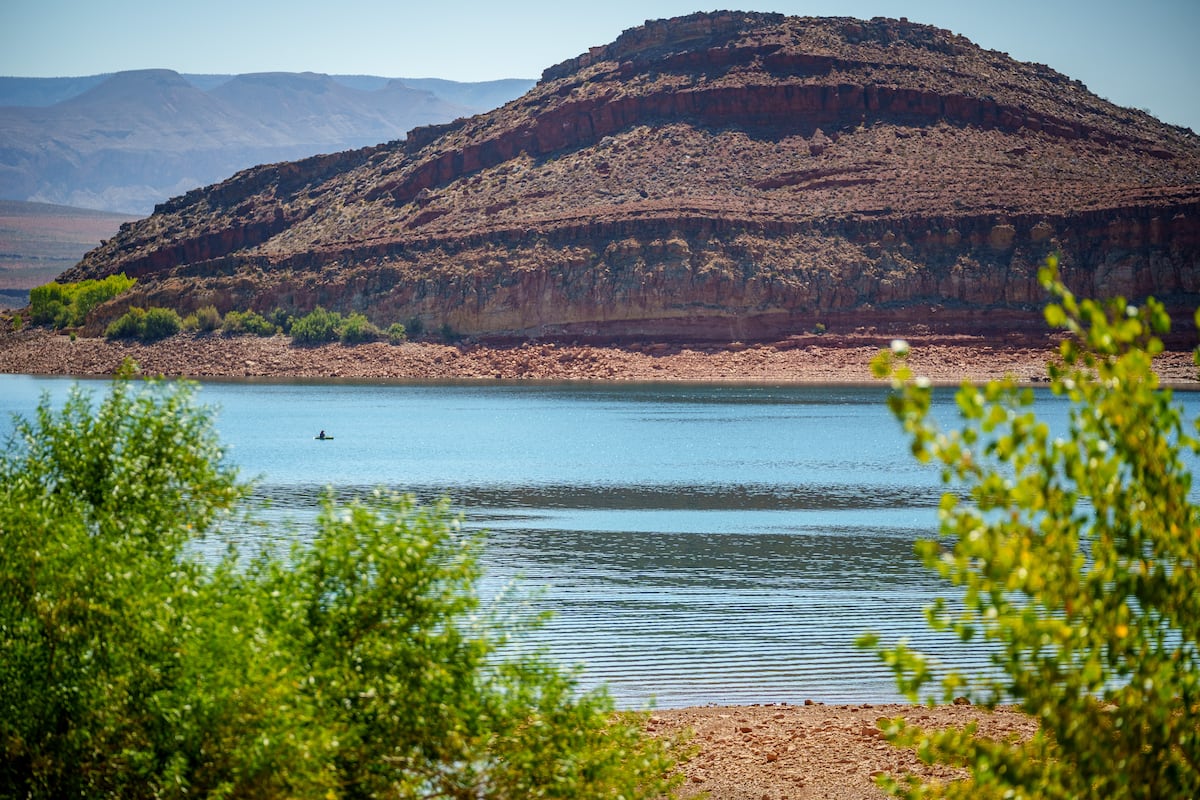Shortages could trigger severe restrictions under new plan adopted by the water district
(Trent Nelson | The Salt Lake Tribune) Quail Creek Reservoir in Hurricane on Tuesday September 16, 2025.
St. George • Imagine a Washington County where all splashpads and water parks go dry, washing cars is banned and lawns wither and die because irrigation is ditched except at community recreation centers.
While most would prefer such draconian measures be left to the imagination, those are some actual worst-case options cities could choose under the Water Shortage Contingency Plan adopted this week to safeguard the drought-prone region’s water supply during times of emergency.
Nearly four years in the making, the comprehensive plan the Washington County Water Conservancy District’s board approved is being hailed as a landmark achievement.
“I’m grateful our city leaders came together to meet Washington County’s unique challenges in ensuring a reliable water supply,” district general manager Zach Renstrom said in a statement. “The plan protects drinking water during any event that could disrupt water delivery.”
The district’s plan, adopted with the blessing of all eight of its member cities, is timely. The county is currently mired in severe drought. And the last water year that wrapped up at the end of September was the ninth-driest on record for the St. George area, Glen Merrill, hydrologist for the National Weather Service’s Salt Lake City office, recently told The Tribune.
Those conditions put pressure on the district board and municipal elected officials to get a plan in place in the event this water year is as poor as the last one, a scenario Renstrom has stated could strain the water-storage system.
Alas, coming up with a plan that could pass municipal muster was not easy. Some mayors balked at the previous iteration the district pitched, which would have empowered the district to impose water cuts and restrictions on its eight member cities under certain scenarios.
Under the approved plan, the district board members can declare a water shortage, allowing them to implement specific water use reductions. However, officials in member cities have the flexibility to determine the most effective ways to achieve these cuts if a severe drought, earthquake, or other disaster jeopardizes or depletes the water supply.
Doug Bennett, district conservation manager, said providing cities with more flexibility was critically important.
“There wasn’t complete consensus on the first plan we put out,” he said. “That’s not what you want when you are having to deal with a potential emergency. You want to make sure that everybody is 100% [on] the same playbook.”
Restrictions would come in stages
The district has developed a drought monitoring tool that analyzes factors like reservoir levels, streamflows, and climate conditions, which they use in their considerations about when to declare a shortage and which stage to declare.
Under the plan, the district board can declare four stages of shortage, ranging from “caution” to “crisis” that could require cities to cut water use between 10% and 60%. Once a shortage stage has been declared, each city would be given a water budget based on the number of residential connections it has.
Cities that exceed their water budget could face a significant increase in the price charged by the district, ranging from 300% to 500%, according to Bennett. These price hikes would apply only to the water consumed in excess of their allocated budget.
District board members could change the shortage stage, and they have the authority to impose additional requirements on cities that fall short of their water-reduction requirements.
Cities have now been tasked with drawing up plans that outline the measures they will take to meet the targeted water-use reductions in each of the four stages should a shortage be declared. In stage one, the mildest situation, cities could choose from a variety of options, such as reducing irrigation at public facilities by 10% or banning lawn installations between May and September.
In stage four, the most dire category, the district suggests substantial water rate hikes, bans on outdoor water use, such as for splashpads and washing cars, and a 60% reduction in the water used for irrigation at public buildings and golf courses, among others.
“We certainly hope that it doesn’t become necessary to enact the reduction measures that progressively increase based on drought severity, but we are planning … for that possibility,” said Washington City Mayor Kress Staheli, who also sits on the district board.
Bennett said the goal is for cities to have their action plans in place by May.
Conservationists welcome plan
Besides enjoying the support of the district and municipal officials, the new shortage plan has also been lauded by conservationists.
“The final plan includes several key elements CSU has long advocated for, including water-use limits that tighten during drought stages, clear expectations for how each city will stay within those limits, and significant pricing penalties when those limits are exceeded,” Conserve Southwest President Edward Andrechak said.
Approval of the water shortage plan comes several weeks after district officials signed off on the state’s first regional water plan, which outlines their strategy to conserve 1.7 billion gallons by 2030.
